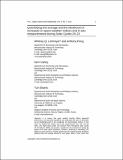Quantifying the average and the likelihood of increases in space weather indices and in situ measurements during Solar Cycles 20–23
Author(s)
Lohmeyer, Whitney Q.; Pang, Anthony; Cahoy, Kerry; Shprits, Yuri
Download2014-IJSpaceSE Lohmeyer.pdf (920.8Kb)
Metadata
Show full item recordAbstract
It is known that space weather harshly affects spacecraft performance, yet spacecraft operations and understanding the cause of anomalies can be challenging due to the complexity of environmental metrics. In this work, we analyse five metrics and in-situ measurements (Kp, Dst, and AE index, and high-energy proton and electron flux) throughout Solar Cycles 20–23 (1964 to 2008), and provide a baseline for the environment during the phases of the solar cycles (maximum, minimum, declining or ascending). We define increased activity as activity greater than two median absolute deviations (MADs) above the average activity for each phase. MAD is used, rather than standard deviation, because it is more resilient to outliers. The average and MAD values are tabulated in Table 3 to Table 6. We determine the probability that increased activity occurs 3, 14 or 30 days before a random day to distinguish between increased/quiet activities and to aid in correlating intensifications of the environment and anomalous satellite performance.
Date issued
2013-01Department
Space Telecommunications Astronomy and Radiation (STAR) Lab; Massachusetts Institute of Technology. Department of Aeronautics and AstronauticsPublisher
International Journal of Space Science and Engineering
Citation
Lohmeyer, W. Q., Pang, A., Cahoy, K., & Shprits, Y. (2013). Quantifying the average and the likelihood of increases in space weather indices and in situ measurements during Solar Cycles 20–23. International Journal Of Space Science And Engineering, 1(3), 230.
ISSN
20488459
20488467
Keywords
satellite anomalies, radiation effects, space weather indices, space weather measurements